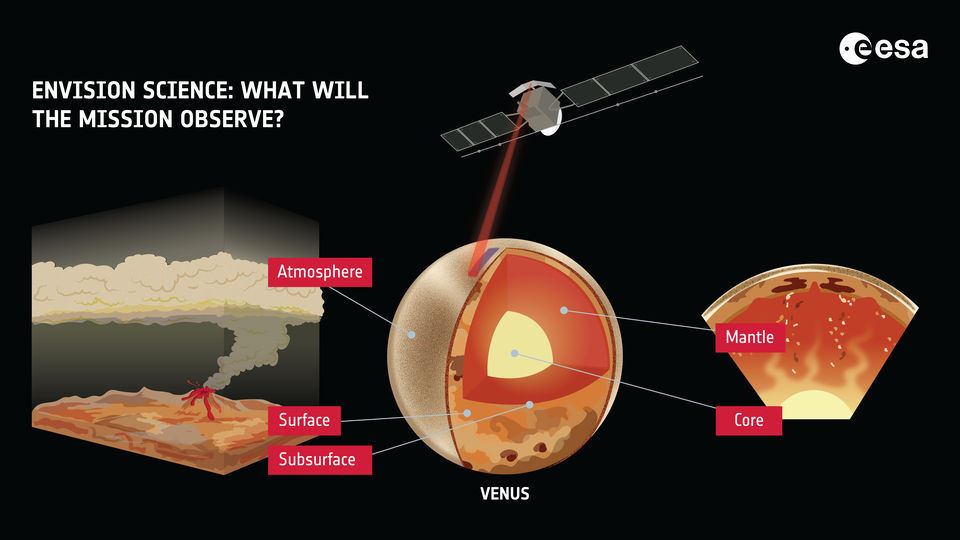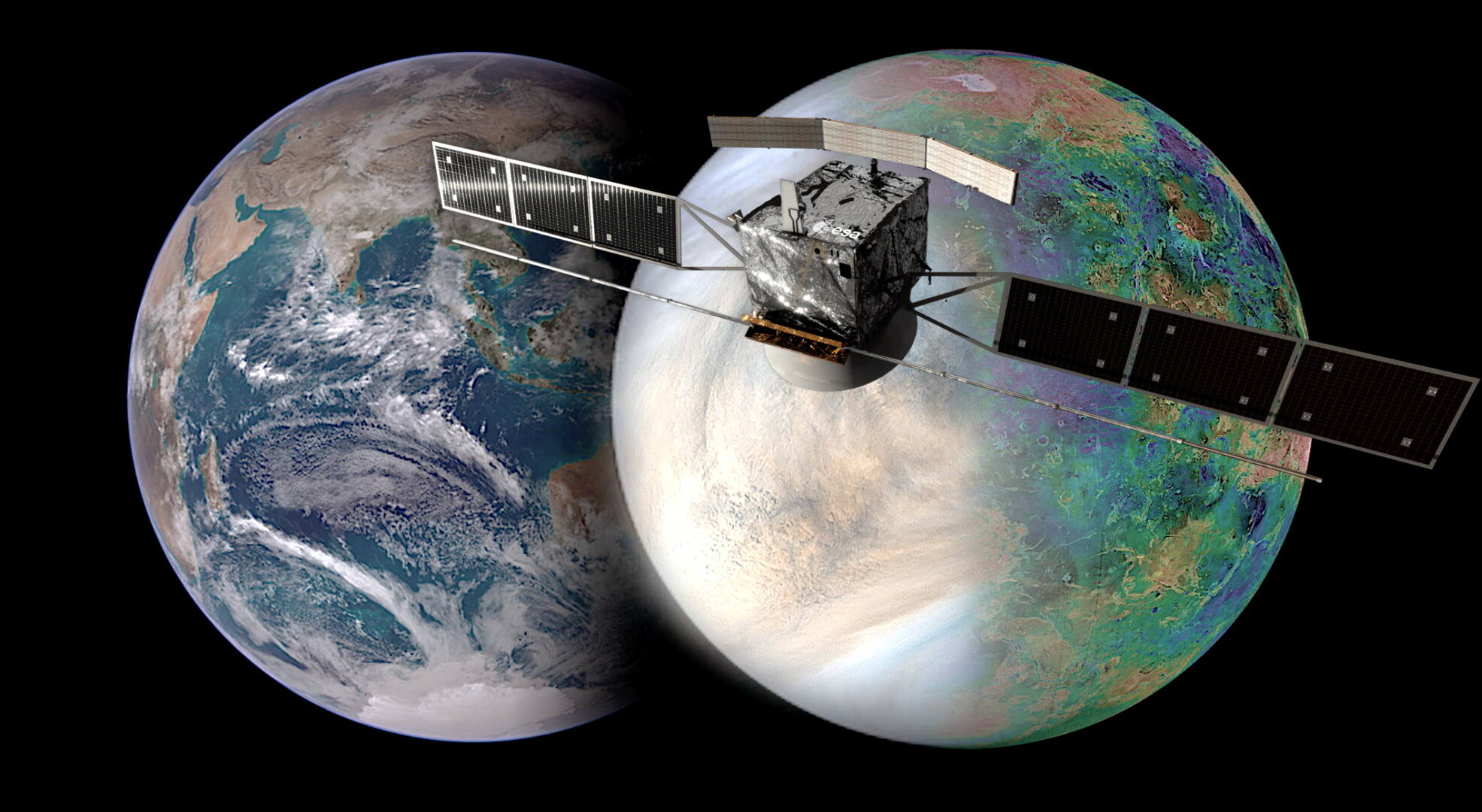Go-ahead for EnVision mission
ESA’s Science Program Committee (SPC) has just approved the start of development of the EnVision mission, dedicated to the study of Venus as part of the Cosmic Vision program’s M5 mission. Launch is scheduled with Ariane 6 in 2031.
EnVision will study Venus from the depths of its core to its atmosphere, providing important new information on the planet’s history, geological activity and climate. Adoption means that the study phase is complete and ESA is committed to implementing the mission. Following the selection of the European industrial contractor later this year, work will begin on finalizing the design and development of the probe. Scientific operations will begin in 2035, after a 15-month phase of aerobraking in Venus’s upper atmosphere prior to stationing in low polar orbit.
EnVision’s measurements will help to resolve some of the unsolved questions surrounding Venus. For example, EnVision will reveal how volcanoes, plate tectonics and asteroid impacts have shaped the surface of Venus, as well as the nature and current level of geological activity on the planet. The mission will also explore the planet’s interior, gathering data to constrain the structure and size of Venus’ core, mantle and crustal thickness. Finally, it will study the weather and climate on Venus, particularly from the point of view of its interactions with the surface and its geological activity.

The scientific goals of the EnVision mission. Copyright @ESA
EnVision will carry a diverse collection of scientific instruments. It will be the first mission to probe directly beneath the surface of Venus, using subsurface penetrating radar. A second radar instrument, VenSAR, will map the surface with a resolution of up to 10 meters and determine properties such as surface texture. Three different spectrometers will study the composition of the surface and atmosphere. Finally, a radio science experiment will use radio waves to study the planet’s internal structure and atmospheric properties.

EnVision : understanding the reasons why Venus and the Earth look so different although they are so close. Copyright @ESA
EnVision will be part of a truly international exploration program towards Venus. Anticipating a fruitful collaboration, NASA has also selected two new missions to Venus as part of its Discovery program: DAVINCI (Deep Atmosphere Venus Investigation of Noble gases, Chemistry, and Imaging) and VERITAS (Venus Emissivity, Radio Science, InSAR, Topography, and Spectroscopy). Together, EnVision, DAVINCI and VERITAS will provide the most comprehensive study of Venus ever carried out.
The French contribution to the mission
The French contribution to EnVision is very significant: in addition to responsibility for the radio-science experiment via the Planetology and Geosciences Laboratory of Nantes Université (PI: Caroline Dumoulin), the VenSpec-U ultraviolet spectro-imager will be built by a consortium of French space laboratories (LATMOS, LESIA, IRAP) led by LATMOS (PI: Emmanuel Marcq), and the optical part of the VenSpec-M infrared multi-spectral imager will be provided by the LESIA laboratory, with resources and technical support from CNES. The radio-science experiment will use the communication link between the probe and the Earth to determine the spacecraft’s orbit, enabling a precise reconstruction of Venus’s gravity field, and thus probing Venus’s internal structure. Crossing the atmosphere via the radio link will also enable us to measure atmospheric pressure and temperature, as well as cloud composition. The ultraviolet spectro-imager will measure sulfur gases (sulfur dioxide and sulfur monoxide) of potential volcanic origin above the clouds, as well as several properties of the droplets forming these clouds (including their ultraviolet absorption, which remains mysterious). Finally, the multispectral infrared imager will measure the properties and nature of the rocks on the entire surface of Venus, the water vapor in the lower atmosphere, and the thermal emission characteristic of volcanic activity.
IRAP’s contribution to the mission
IRAP is heavily involved in the EnVision mission, via :
- Scientific co-leadership of the VenSpec-U UV imaging spectrometer, led by co-PI Jérémie Lasue at IRAP. This instrument will measure sulfur gases above the clouds and study the spatial variability of cloud tops on scales ranging from 6 km to planetary scale.
- Responsibility for the mechanical development of the VenSpec-U instrument, and participation in the Assembly, Integration and Testing of the various prototypes and models, as well as the calibrations to be carried out on the ground.
- Development of the door mechanism to protect the instrument from light and molecular contamination.
European partners
The mission’s imaging spectrometers are being developed in partnership with a consortium of French laboratories for the ultraviolet channel (PI: Emmanuel Marcq LATMOS), and German and Belgian laboratories for the infrared channels (PI: Jörn Helbert, DLR ; PI: Ann Carine Vandaele, BISA).
Further Resources
- Press Releases :
- We’re heading for Venus: ESA approves EnVision (ESA)
- Feu vert pour les missions spatiales EnVision et LISA de l’ESA (CNRS / CNES / CEA)
- Website dedicated to the mission
IRAP Contacts
- Jérémie Lasue, jeremie.lasue@irap.omp.eu
- Romain Mathon Romain.Mathon@irap.omp.eu






